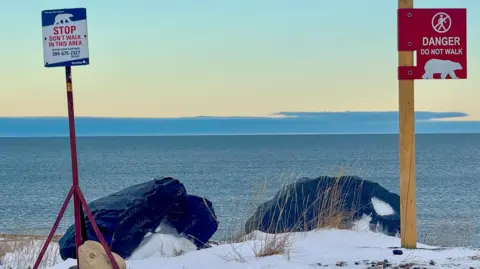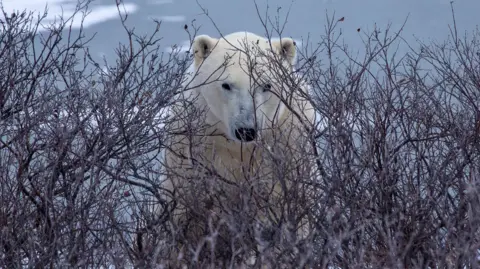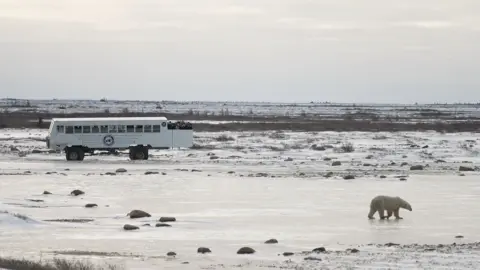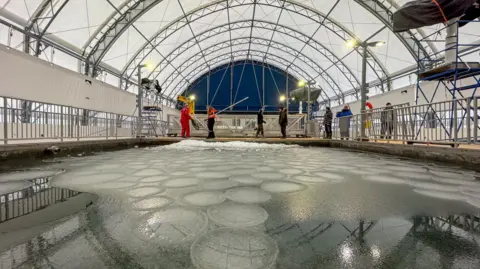Bother in Arctic as polar bears and other people face warming world

“Can I provide you with some polar bear recommendation?” asks Tee, a assured 13-year-old we meet throughout a go to to Churchill’s highschool.
“If there is a bear this near you,” she says as she measures a distance of about 30cm together with her fingers. “Make a fist and punch it within the nostril.
“Polar bears have very delicate noses – it’s going to simply run away.”
Tee has not needed to put this recommendation to the check. However rising up right here – alongside the planet’s largest land predator – means bear security is a part of on a regular basis life.
 Victoria Gill/BBC
Victoria Gill/BBCIndicators – in retailers and cafes – remind anybody heading exterior to be “bear conscious”. My favorite reads: “If a polar bear assaults you will need to struggle again.”
Working away from a charging polar bear is – maybe counterintuitively – harmful. A bear’s intuition is to chase prey and polar bears can run at 25mph (40kmph).
Key recommendation: Be vigilant and conscious of your environment. Do not stroll alone at night time.
 Victoria Gill/BBC
Victoria Gill/BBCChurchill is named the polar bear capital of the world. Yearly, the Hudson Bay – on the western fringe of which the city is perched – thaws, and forces the bears on shore. Because the freeze units in in Autumn, lots of of bears collect right here, ready.
“We’ve freshwater rivers flowing into the world and chilly water coming in from the Arctic,” explains Alyssa McCall from Polar Bears Worldwide (PBI). “So freeze-up occurs right here first.
“For polar bears, sea ice is a giant dinner plate – it is entry to their foremost prey, seals. They’re most likely excited for a giant meal of seal blubber – they have not been consuming a lot all summer time on land.”
 Victoria Gill/BBC
Victoria Gill/BBCThere are 20 identified sub-populations of polar bears throughout the Arctic. This is among the most southerly and greatest studied.
“They’re our fats, white, bushy canaries within the coal mine,” Alyssa explains. “We had about 1,200 polar bears right here within the Nineteen Eighties and we have misplaced nearly half of them.”
The decline is tied to the period of time the bay is now ice-free, a interval that’s getting longer because the local weather warms. No sea ice means no frozen seal-hunting platform.
“Bears right here at the moment are on land a few month longer than their grandparents have been,” explains Alyssa. “That places stress on moms. [With less food] it is tougher to remain pregnant and to maintain these infants.”
Whereas their long-term survival is precarious, the bears draw conservation scientists and hundreds of vacationers to Churchill yearly.
We tag together with a bunch from PBI to seek for bears on the sub-Arctic tundra – just some miles from city. The crew travels in a tundra buggy, a sort of off-road bus with enormous tyres.
 Kevin Church/BBC
Kevin Church/BBCAfter just a few distant sightings, now we have a heart-stopping shut encounter. A younger bear approaches and investigates our sluggish two-buggy convoy. He sidles up, sniffs one of many autos, then jumps up and crops two large paws up on the facet of the buggy.
The bear casually slumps again down onto all fours, then appears up and gazes at me briefly. It’s deeply complicated to look into the face of an animal that’s concurrently lovely and probably lethal.
“You may see him sniffing and even licking the automobile – utilizing all his senses to analyze,” says PBI’s Geoff York, who has labored within the Arctic for greater than three many years.
 Kevin Church/BBC
Kevin Church/BBCBeing right here in ‘bear season’ means Geoff and his colleagues can check new applied sciences to detect bears and shield individuals. The PBI crew is presently fine-tuning a radar-based system dubbed ‘bear-dar’.
The experimental rig – a tall antenna with detectors scanning 360 levels – is put in on the roof of a lodge in the midst of the tundra, close to Churchill.
“It has synthetic intelligence, so right here we will mainly train it what a polar bear is,” Geoff explains. “This works 24/7, it could see at night time and in poor visibility.”
 Kevin Church/BBC
Kevin Church/BBC Annie Edwards
Annie EdwardsDefending the neighborhood is the duty of the polar bear alert crew – skilled rangers who patrol Churchill each day.
We journey together with ranger Ian Van Nest, who’s in search of a cussed bear that he and his colleagues tried to ward off earlier that day. “It rotated and got here again [towards] Churchill. He would not appear inquisitive about going away.”
For bears which might be intent on hanging round city, the crew can use a reside lure: A tube-shaped container, baited with seal meat, with a door that the bear triggers when it climbs inside.
“Then we put them within the holding facility,” Ian explains. Bears are held for 30 days, a interval set to show a bear that it’s a detrimental factor to return to city in search of meals, however that does not put the animal’s well being in danger.
They’re then moved – both on the again of a trailer or often air-lifted by helicopter – and launched additional alongside the bay, away from individuals.
 Victoria Gill/BBC
Victoria Gill/BBCCyril Fredlund, who works at Churchill’s new scientific observatory, remembers the final time an individual was killed by a polar bear in Churchill, in 1983.
“It was proper on the town,” he says. “The person was homeless and was in an deserted constructing at night time. There was a younger bear in there too – it took him down with its paw, like he was a seal.”
Individuals got here to assist, Cyril remembers, however they could not get the bear away from the person. “It was prefer it was guarding its meal.”
 Victoria Gill/BBC
Victoria Gill/BBCThe polar bear alert program was arrange round that point. No-one has been killed by a polar bear right here since.
Cyril is now a technician on the new Churchill Marine Observatory (CMO). A part of its remit is to grasp precisely how this atmosphere will reply to local weather change.
Beneath its retractable roof are two large swimming pools crammed with water pumped in instantly from the Hudson Bay.
 Victoria Gill/BBC
Victoria Gill/BBC“We will do every kind of managed experimental research trying into adjustments within the Arctic,” says Prof Feiyue Wang.
One implication of a much less icy Hudson Bay is an extended working season for the port, which is presently closed for 9 months of the 12 months. An extended season throughout which the bay thaws and turns into open water might imply extra ships coming out and in of Churchill.
Research on the observatory are getting down to enhance the accuracy of the ocean ice forecast. Analysis can even look at the dangers related to increasing the port. One of many first investigations is an experimental oil spill. Scientists plan to launch oil into one of many swimming pools, check clean-up strategies and measure how rapidly the oil degrades within the chilly water.
For Churchill’s mayor, Mike Spence, understanding tips on how to plan for the long run, notably relating to delivery items out and in of Churchill, is significant for the city’s future in a warming world.
“We’re already trying into extending the season,” he says, gesturing in the direction of the port, which has ceased working for the winter. “In ten years’ time, this can be bustling.”
 Victoria Gill/BBC
Victoria Gill/BBCLocal weather change poses a problem for the polar bear capital of the world, however the mayor is optimistic. “We’ve a fantastic city,” he says, “a beautiful neighborhood. And the summer time season – [when people come to see the Beluga whales in the bay] – is rising.”
“We’re all being challenged by local weather change,” he provides. “Does that imply you cease current? No – you adapt. You’re employed out tips on how to make the most of it.”
Whereas Mike Spence says “the long run is brilliant” for Churchill, it won’t be so brilliant for the polar bears.
Tee and her buddies look out over the bay, from a window in the back of the college constructing. The polar bear alert crew’s autos are gathering exterior, making an attempt to maneuver a bear away from city.
“If local weather change continues,” muses Tee’s classmate Charlie, “the polar bears would possibly simply cease coming right here.”
The trainer approaches to ensure the youngsters have somebody coming to choose them up – that they don’t seem to be strolling house alone. All a part of the each day routine within the polar bear capital of the world.
 Kate Stephens/BBC
Kate Stephens/BBC






